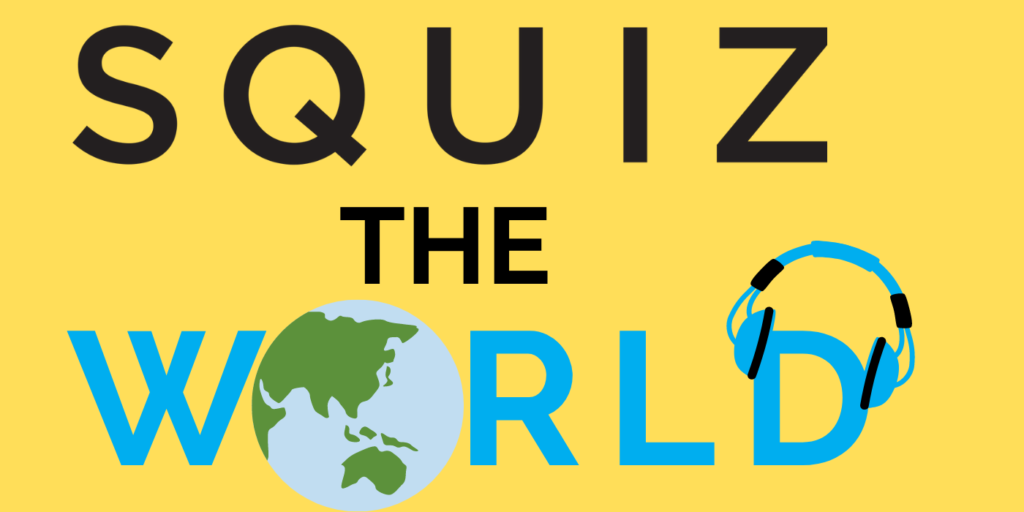
Squiz the World goes to… The Torres Strait Islands
LINKS:
Traditional Torres Strait Islander stories told in language: https://www.slq.qld.gov.au/discover/aboriginal-and-torres-strait-islander-cultures-and-stories/contemporary-stories/retold#
The First Shave pt. 1: https://www.youtube.com/watch?v=ETm0yN4yeaI
Part 2: https://www.youtube.com/watch?v=7xKk22RKURU
Zamiyakal (Dance Machine): https://www.youtube.com/watch?v=k4QsGl6Vhwg
Ken Thaiday, master zamiyakal maker: https://www.youtube.com/watch?v=_LOPVNEOBeY
Fire-fire chicken and sop-sop: https://laurelsaussiecookery.wordpress.com/recipes/torres-strait-cookery/
EPISODE TRANSCRIPT
Each week, we give the world globe a spin, and see where we land. Then we take the kids of Australia on an audio excursion to visit that country and its people.
I’m Amanda Bower, and today on Squiz the World we’re visiting the Torres Strait. It’s NAIDOC week —and the “I” in NAIDOC stands for Islanders.
So put on your sunscreen, get your fishing tackle ready, and strap yourselves into the Squiz Kids Super Fast Supersonic Jetliner as we take off and take a squiz at the Torres Strait …
Just the Facts
Now, you might be thinking… hang on, Amanda, Squiz the World travels to a different COUNTRY each week, and most of the islands in the Torres Strait are part of Australia!
Well… yes… but they’re what’s known as an “autonomous region”. Autonomous means that you have the freedom to govern yourself. The Torres Strait Regional Authority, whose 20 members are elected by locals, has special powers that no other elected body in Australia has.
Let’s back up a bit, though. Where and what is the Torres Strait?
A strait—that’s s-t-r-a-i-t—is a narrow passage of water connecting two bigger ones. And if you look at the very top of Australia, you’ll see that there’s a passage of water between Papua New Guinea to the north, and the northern tip of Queensland to the south. Back in 1606, the Spanish navigator Luis de Vaez Torres sailed through the 150-kilometer-wide strait… and now it bears his name.
It would be silly to say he “discovered” the strait, when the indigenous people – who are physically and culturally different from Aboriginal Australians – had been living there for thousands of years… although only 18 of the 200-plus islands in the strait are populated, mostly because the others don’t have enough fresh water for people to survive.
Some are coral islands, with the kind of crystal clear water you see on postcards… on others, mountains rise high in the sky. The capital, Thursday Island, is in the south. And way up in the northern strait, there’s a cluster of islands that has continued its traditional trading with Papua New Guinea… no passports required.
In total, about 8,000 people live in the Torres Strait, and over 90% of them are indigenous islanders. One of the most famous is Eddie Mabo, who came from the island of Mer. He led the historic Native Title case that saw Australia’s high court recognise in 1992 that Indigenous people are the original owners of our land—before then, the law was based on the white settlers’ claim that the land was unoccupied and unowned before they came here. Many more successful land rights claims have followed, so Eddie Mabo was a real pioneer for Aboriginal and Torres Strait Islanders.
Whenever you travel, it’s important to learn a few words in that country’s language. It’s a great way to show respect. So, let’s….
Learn the Lingo
There are three languages other than English spoken in the Torres Strait Islands: Yumplatok, which is the most common, is a mix of English and other languages. Then there’s Meriam Mir, which is spoken in the Eastern Islands by just over 200 people; and Kalau Lagau Ya, which is spoken in the other islands. Both are considered endangered languages. One way to keep them alive is to teach kids through stories – I’ve put a link in your episode notes – and songs.
And we are SO lucky that the students at Our Lady of the Sacred Heart School, on Thursday Island, have recorded a good morning song in language for us… How lucky are we? Let’s have a closer listen.
(audio of kids singing)
Amazing. Thank you so much. The Yumplatok word for thank you is “esso”, which I love because it also means “respect”. Speaking someone’s language, saying “thank you”… it’s really all about respect, isn’t it?
Now that we can communicate a little bit, it’s….
Time for School
Because the Torres Strait Islands are part of Australia, school isn’t all THAT different there from the mainland. But that’s not always be a good thing. Lessons are taught in English, and for many kids, that’s their second or even third language… meaning that it can be hard to get the results you’re capable of, if you’re not understanding as well. And the books teachers use come mostly from the mainland, so they may not have pictures or stories that reflect the world that kids in the Torres Strait are living in. Teachers might have to explain to kids what it means to buy a train ticket… and it’s harder to learn when you can’t make connections.
Remember I said that there were some different school rules in the Torres Strait? Well, one is that you’re allowed to take time off to shave!
When puberty finally catches up with boys in the Torres Strait, they are allowed to skip school for their first shave ceremony. This is a really big moment in a kid’s life. Because uncles and aunties are responsible for a lot of a kid’s education in culture, the boy is shaved by his uncles, and then taken out fishing, to spear his very first turtle or dugong. I’ve put a link to a shave ceremony video in your episode notes.
A huge feature of all Torres Strait Island ceremonies is music and dancing. And one of the best things about visiting another country is immersing yourself – that means surrounding yourself – in a different culture. So, ….
Let’s Get Cultural
Traditional dancing is a major way of expressing yourself in the Torres Strait. Each clan and each island group has its own unique styles, including their own style of something called “dance machines.”
Called zamiyakal (zam ee yak al) in Kalau Lagau Ya, these dance machines are mechanical moving objects that tell part of the story of the dance. For example, a wooden headdress might be of a bird, with different parts connected by fishing line. When the dancer pulls on the line, the bird’s wings move. Or a shark can open and close its jaws. I’ve put a link in your episode notes to a dance from Urab island which isn’t fantastic quality video, but the zamiyakal is soooo cool, I just had to include it.
There’s also a video about Ken Thaiday, a master zamiyakal maker. He has pieces in art galleries all over the world!
Okay, all that dancing has made me starving! I think it might be…
Dinner Time
Throughout the islands, even where good land is limited and rainfall uncertain, there are usually a few coconut palms, plantains, bananas, pawpaws or mangoes in the gardens of people’s houses, and each family owns a patch of land somewhere to grow cassava, sweet potatoes, yams, taro, pumpkins, sugar cane or other crops.
When Japanese and other Asian people came to the islands in the 1860s to starting diving for pearls, they introduced new flavours… including chilli, garlic, and curry.
But there’s one thing that’s always been central to Torres Strait food and life: fishing. So in your episode notes, there is a recipe for sop-sop, which a British visitor in the 1940s said he fell in love with when he had it for the first time. Made with vegetables, coconut milk and fish, all wrapped up in a banana leaf, sop-sop cooks slowly on hot stones—although you can make it in a saucepan, too. Yummmm.
The S’Quiz
This is the part of the podcast where you get to test how well you’ve been listening.
Question 1. Who in a Torres Strait Islander boy’s family gives him his first shave?
Question 2. What does “esso” – thank you in Yumplatok – also mean?
Question 3. Who was the Torres Strait Islander who made land rights history?
